
It is said that the dishes are much like the highlander character – expressive and sharp. Although local cuisine is not the most exquisite, it captivates us with perfect, flavoursome combinations and simplicity.
Regional specialities, among which products made from sheep’s milk enjoy the biggest appreciation, have developed with time but the original recipes, passed on down the generations, are still mastered in traditional eateries.
A hundred or so years ago, life in Zakopane was full of hardships. The highland cuisine was limited. Lamb and beef were served only on special or festive occasions. What was generally eaten was sauerkraut soup and boiled potatoes. Nothing was wasted in those times, not even leftover potatoes from lunch, which were made into ‘moskole’ on a hot plate. These were eaten widely instead of bread and they tasted great with a little butter on them.
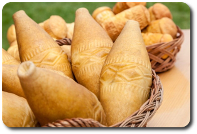 OSCYPEK A hard, smoked cheese made from sheep’s milk, became the nation’s first product to be protected under EU regulations in 2007. The cheese, shaped like double scones, is formed manually and then submerged in salty wated before being placed on special shelves high under the shepherds roof, where it is cured by smoke of the open fire. Nowadays, it is generally grilled, giving it a chewy texture and a lovely, salty flavour and eaten with cranberry sauce (zurawina).
OSCYPEK A hard, smoked cheese made from sheep’s milk, became the nation’s first product to be protected under EU regulations in 2007. The cheese, shaped like double scones, is formed manually and then submerged in salty wated before being placed on special shelves high under the shepherds roof, where it is cured by smoke of the open fire. Nowadays, it is generally grilled, giving it a chewy texture and a lovely, salty flavour and eaten with cranberry sauce (zurawina).
 KWASNICA The sour soup is a traditional highlander dish, made from sauerkraut, mutton ribs, potatoes, mushrooms and spices with a large share of sauerkraut juice, usually eaten with potatoes or bread. A good “Kwasnica” is very tangy and is not cooked with other vegetables, unlike a close ‘cousin’ of the soup called “Kapusniak”. Kwasnica is also a fantastic cure for hangover!! :-))
KWASNICA The sour soup is a traditional highlander dish, made from sauerkraut, mutton ribs, potatoes, mushrooms and spices with a large share of sauerkraut juice, usually eaten with potatoes or bread. A good “Kwasnica” is very tangy and is not cooked with other vegetables, unlike a close ‘cousin’ of the soup called “Kapusniak”. Kwasnica is also a fantastic cure for hangover!! :-))
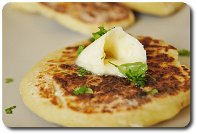 MOSKOLE Due to the simplicity of preparing potatoes, the vegetable also being one of the only crops to grow in the harsh environment, the mountaineer kitchens included many varieties, such as noodles and dumplings. During WWI, moskole made their debut on the local tables having been brought over by the Russian troops fighting in the area.
MOSKOLE Due to the simplicity of preparing potatoes, the vegetable also being one of the only crops to grow in the harsh environment, the mountaineer kitchens included many varieties, such as noodles and dumplings. During WWI, moskole made their debut on the local tables having been brought over by the Russian troops fighting in the area.
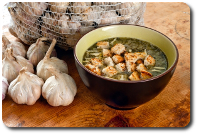 CZOSNIANKA Czosnianka is a soup cooked with potato, garlic, onion and mint – dried or fresh. The potatoes are boiled and drained before being placed into boiling water again with added chopped garlic, onion and mint. Lightly seasoned with salt. The dish is now a rarity and replaced in most restaurants by a light chicken soup, served with potatoes or croutons.
CZOSNIANKA Czosnianka is a soup cooked with potato, garlic, onion and mint – dried or fresh. The potatoes are boiled and drained before being placed into boiling water again with added chopped garlic, onion and mint. Lightly seasoned with salt. The dish is now a rarity and replaced in most restaurants by a light chicken soup, served with potatoes or croutons.
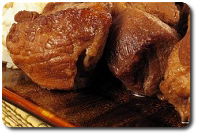 BARANINA The basis of highland meat dishes is, of course, lamb. Most frequently roasted chops, the secrets lie in curing the meat to achieve a unique flavour found in the dishes. While highlanders ate meat rarely, the local outlaws based their diet on the greatest delicacies, such as bear liver. Some had a habit of drinking bear fat. Sabala, a local legend, once boasted of drinking a hat full of the grease and not experiencing any illness for six years straight.
BARANINA The basis of highland meat dishes is, of course, lamb. Most frequently roasted chops, the secrets lie in curing the meat to achieve a unique flavour found in the dishes. While highlanders ate meat rarely, the local outlaws based their diet on the greatest delicacies, such as bear liver. Some had a habit of drinking bear fat. Sabala, a local legend, once boasted of drinking a hat full of the grease and not experiencing any illness for six years straight.
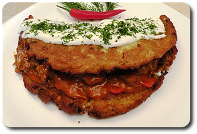
PLACEK PO ZBOJNICKU A huge serving of potato pancake, served with ‘Gulasz’ (lamb stew). The name means “pancake a la Outlaw” and suggests that the first people to dine in such way were indeed groups of men in the area who had the means of obtaining regular supplies of meat in somewhat unorthodox fashion.
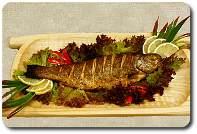 PSTRAG Despite Tatra streams being full of fish, which are considered a huge part of people’s diet worldwide, the Podhale highlanders rarely used to dip in for the swimming snack until the 20th century. Since then, trout has gained popularity in the region and can be found on the menu in almost every good restaurant in the region. Fried and served with either potatoes, salad or a side of chips.
PSTRAG Despite Tatra streams being full of fish, which are considered a huge part of people’s diet worldwide, the Podhale highlanders rarely used to dip in for the swimming snack until the 20th century. Since then, trout has gained popularity in the region and can be found on the menu in almost every good restaurant in the region. Fried and served with either potatoes, salad or a side of chips.

ZENTYCA Zentyca is a drink made of sheep milk whey; a by-product in the process of making bundz cheese. Traditionally, this drink is served in a ‘czerpak’ which is a large, decorated wooden cup, drank chilled, sweet or sour and in the 19th century was used as treatment for respiratory disease.
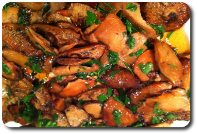 RYDZE NA MASLE The aptly named “Lactarius deliciosus” Saffron Milk Cap or Red Pine Mushroom is deliciosus indeed! Shallow fried in butter and spread over some Polish bread. Heaven! The tastebud tingling mushroom is a genetically, morphologically, and ecologically distinct European species that does not occur in North America, which basically means it’s good to be in Zakopane around September, when the season for these golden delicacies is in full flow.
RYDZE NA MASLE The aptly named “Lactarius deliciosus” Saffron Milk Cap or Red Pine Mushroom is deliciosus indeed! Shallow fried in butter and spread over some Polish bread. Heaven! The tastebud tingling mushroom is a genetically, morphologically, and ecologically distinct European species that does not occur in North America, which basically means it’s good to be in Zakopane around September, when the season for these golden delicacies is in full flow.
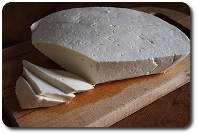 BUNDZ Bundz is the mildest type of curd cheese produced from sheep’s milk during the season in a very unique way. The taste is mild, gentle, clear and slightly sweet. During ripening, a slightly sour flavour develops as the cheese is left to mature for a few days. As the curd seperates from the whey, it gets whipped off using a special wooden spatula. The next step is to allow it to settle. Once the lumps fall to the bottom of the barrel, the whey is put aside to make more cheese, or drank as Zetyca. The cheese is then kneaded by hand and hung on the walls to dry inside the highlander’s hut. Once dry, it’s put on a shelf to mature for up to two weeks.
BUNDZ Bundz is the mildest type of curd cheese produced from sheep’s milk during the season in a very unique way. The taste is mild, gentle, clear and slightly sweet. During ripening, a slightly sour flavour develops as the cheese is left to mature for a few days. As the curd seperates from the whey, it gets whipped off using a special wooden spatula. The next step is to allow it to settle. Once the lumps fall to the bottom of the barrel, the whey is put aside to make more cheese, or drank as Zetyca. The cheese is then kneaded by hand and hung on the walls to dry inside the highlander’s hut. Once dry, it’s put on a shelf to mature for up to two weeks.
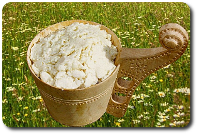
BRYNDZA Alternatively, the Bundz is once again broken down and ground up with salt to make Bryndza, which is matured for longer and has a more dense texture. Ideal as a spreadable, Bryndza is also protected under EU regulations and is only produced in limited areas around the Tatra region by licenced shepherds.





